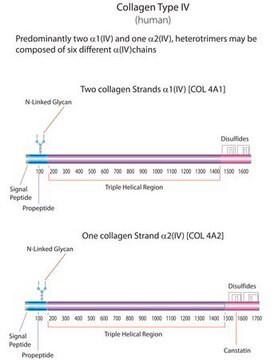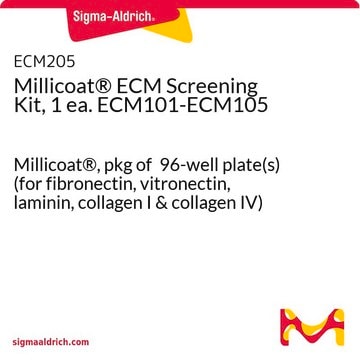ECM105
Human Collagen Type IV
MILLICOAT® Human Collagen Type IV Coated Strips (96-Wells), suitable for cell culture
Synonyme(s) :
Formerly under the CytoMatrix ™ brand name.
About This Item
Produits recommandés
product name
Millicoat® Human Collagen Type IV Coated Strips (96-Wells), 96-well plate coated with human Collagen Type IV used for cell adhesion studies.
Niveau de qualité
Espèces réactives
human
Fabricant/nom de marque
Chemicon®
Millicoat®
Technique(s)
activity assay: suitable
cell based assay: suitable
Entrée
sample type: mouse embryonic stem cell(s)
sample type hematopoietic stem cell(s)
sample type epithelial cells
sample type neural stem cell(s)
sample type induced pluripotent stem cell(s)
sample type pancreatic stem cell(s)
sample type mesenchymal stem cell(s)
sample type: human embryonic stem cell(s)
Numéro d'accès NCBI
Numéro d'accès UniProt
Méthode de détection
colorimetric
Conditions d'expédition
wet ice
Informations sur le gène
human ... COL4A1(1282)
Description générale
Application
NOTE: Optimal assay timing and performance may vary for different cell lines but generally can be obtained using subconfluent cell cultures in the assay described below. Subconfluent cultures can be achieved by splitting cells 1 to 2 days prior to performing the assay.
1. Rehydrate the strips with 200 mL of PBS per well for at least 15 minutes at room temperature. Remove the PBS from the rehydrated strips.
2. Prepare a single cell suspension, preferably using a non-enzymatic dissociation buffer. Optimum cell density may be determined by titration of the cells. A common starting range is between 1x10E05 to 1x10E07 cells/mL.
3. Add 100 mL of the diluted cell suspension to each well. Incubate the plate at 37°C for 45 minutes in a CO2 incubator. Gently wash the plate 2-3 times with PBS containing Ca2+/Mg2+ (200 mL/well).
4. Add 100 mL of 0.2% crystal violet in 10% ethanol to each well. Incubate for 5 minutes at room temperature. Remove the stain from the wells. Gently wash the strips 3-5 times with PBS (300 mL/well) to remove the excess stain.
5. Add 100 mL of Solubilization Buffer (A 50/50 mixture of 0.1M NaH2PO4, pH 4.5 and 50% ethanol) to each well. Allow strips to incubate and gently shake at room temperature until the cell-bound stain is completely solubilized; approximately 5 minutes.
6. Determine the absorbance at 540 - 570 nm on a microplate reader.
Cell Structure
Conditionnement
Stockage et stabilité
Informations légales
Clause de non-responsabilité
Code de la classe de stockage
11 - Combustible Solids
Classe de danger pour l'eau (WGK)
WGK 3
Point d'éclair (°F)
Not applicable
Point d'éclair (°C)
Not applicable
Certificats d'analyse (COA)
Recherchez un Certificats d'analyse (COA) en saisissant le numéro de lot du produit. Les numéros de lot figurent sur l'étiquette du produit après les mots "Lot" ou "Batch".
Déjà en possession de ce produit ?
Retrouvez la documentation relative aux produits que vous avez récemment achetés dans la Bibliothèque de documents.
Les clients ont également consulté
Protocoles
This page covers the ECM coating protocols developed for four types of ECMs on Millicell®-CM inserts, Collagen Type 1, Fibronectin, Laminin, and Matrigel.
Notre équipe de scientifiques dispose d'une expérience dans tous les secteurs de la recherche, notamment en sciences de la vie, science des matériaux, synthèse chimique, chromatographie, analyse et dans de nombreux autres domaines..
Contacter notre Service technique










